Amazon Route 53
Introduction:
Amazon Route 53 is a highly scalable Domain Name System (DNS) web service offered by Amazon Web Services (AWS). Route 53 provides a reliable and cost-effective way to route internet traffic to resources such as Amazon EC2 instances, Amazon S3 buckets, and other AWS services, as well as to resources outside of AWS.
The service helps to translate domain names into IP addresses, which allows users to access web applications and services using easy-to-remember domain names instead of numeric IP addresses. Route 53 also provides a number of features including domain registration, DNS health checks, and traffic management capabilities such as routing policies, latency-based routing, and weighted round-robin.
Route 53’s scalable infrastructure is designed to handle the high query volumes required by large enterprises and internet-scale applications, while maintaining a low latency and high availability of DNS queries. It can be used as a primary DNS service or as a secondary DNS service for disaster recovery and failover scenarios. Additionally, Route 53 can integrate with other AWS services such as Amazon CloudFront, AWS Certificate Manager, and AWS Elastic Load Balancing to provide a comprehensive solution for web application hosting and management.
What Is Amazon Route 53?
Route 53 is a web service that is a highly available and scalable Domain Name System (DNS.)

Amazon Route 53 is a cloud-based Domain Name System (DNS) web service offered by Amazon Web Services (AWS). DNS is a fundamental part of the internet infrastructure that translates domain names, such as www.example.com, into IP addresses, such as 192.0.2.1, that computers use to locate internet resources.
Route 53 provides a highly available and scalable DNS service that can be used to route internet traffic to various resources, including Amazon Web Services (AWS) resources such as Amazon EC2 instances, Elastic Load Balancers, and Amazon S3 buckets, as well as resources outside of AWS.
In addition to DNS services, Route 53 offers advanced features such as DNS health checks, domain registration, and traffic management capabilities, such as latency-based routing and weighted round-robin routing. These features help organizations ensure their web applications and services are highly available, scalable, and performant.
Route 53 is a fully managed service, which means AWS takes care of the underlying infrastructure, including hardware and software updates, so users can focus on building and running their applications. Additionally, Route 53 is designed to integrate with other AWS services, making it a key component of a comprehensive cloud-based infrastructure.
How Amazon Route 53 works?
AWS Route 53 connects requests to the infrastructure running in AWS. These requests include AWS ELB, Amazon EC2 instances, or Amazon S3 buckets. In addition to this, AWS Route 53 is also used to route users to infrastructure outside of AWS.
AWS Route 53 can be easily used to configure DNS health checks, continuously monitor your applications’ ability to recover from failures, and control application recovery with Route 53 Application Recovery Controller. Further, AWS Route 53 traffic flow helps to manage traffic globally via a wide variety of routing types including latency-based routing, geo DNS, weighted round-robin, and geo proximity. All these routing types can be easily combined with DNS Failover in order to enable a variety of low-latency, fault-tolerant architectures.
Let us understand, step by step, how does AWS Route 53 work:
- A user accesses www.example.com, an address managed by Route 53, which leads to a machine on AWS.
- The request for www.example.com is routed to the user’s DNS resolver, typically managed by the ISP or local network, and is forwarded to a DNS root server.
- The DNS resolver forwards the request to the TLD name servers for “.com” domains.
- The resolver obtains the authoritative name server for the domain—these will be four Amazon Route 53 name servers that host the domain’s DNS zone.
- The DNS resolver chooses one of the four Route 53 servers and requests details for the hostname www.example.com.
- The Route 53 name server looks in the DNS zone for www.example.com, gets the IP address and other relevant information, and returns it to the DNS resolver.
- The DNS resolver returns the IP address to the user’s web browser. The DNS resolver also caches the IP address locally as specified by the Time to Live (TTL) parameter.
- The browser contacts the webserver or other Amazon-hosted services by using the IP address provided by the resolver.
- The website is displayed on the user’s web browser.
Now, take a look at the benefits provided by Route 53.
Amazon Route 53 Benefits
Route 53 provides the user with several benefits.
They are:
- Highly Available and Reliable
- Flexible
- Simple
- Fast
- Cost-effective
- Designed to Integrate with Other AWS Services
- Secure
- Scalable
Highly Available and Reliable
- AWS Route 53 is built using AWS’s highly available and reliable infrastructure. DNS servers are distributed across many availability zones, which helps in routing end users to your website consistently.
- Amazon Route 53 Traffic Flow service helps improve reliability with easy re-route configuration when the system fails.
Flexible
- Route 53 Traffic Flow provides users flexibility in choosing traffic policies based on multiple criteria, such as endpoint health, geographic location, and latency.
Simple
- Your DNS queries are answered by Route 53 in AWS within minutes of your setup, and it is a self-service sign-up.
- Also, you can use the simple AWS Route 53 API and embed it in your web application too.
Fast
- Distributed Route 53 DNS servers around the world make a low-latency service. Because they route users to the nearest DNS server available.
Cost-effective
- You only pay for what you use, for example, the hosted zones managing your domains, the number of queries that are answered per domain, etc.
- Also, optional features like traffic policies and health checks are available at a very low cost.
Designed to Integrate with Other AWS Services
- Route 53 works very well with other services like Amazon EC2 and Amazon S3.
- For example, you can use Route 53 to map your domain names or IP addresses to your EC2 instances and Amazon S3 buckets.
Secure
- You can create and grant unique credentials and permissions to each and every user with your AWS account, while you have to mention who has access to which parts of the service.
Scalable
- Amazon Route 53 is designed to automatically scale up or down when the query volume size varies.
These are the benefits that Amazon Route 53 provides, moving on with this what is Amazon Route 53 tutorial, let’s discuss the AWS routing policies.
Amazon Route 53 Limitations
Amazon Route 53 is a robust DNS service with advanced features, but it has several limitations as well. Some of them are discussed below:
- No DNSSEC support: DNSSEC stands for Domain Name System Security Extensions. It is a suite of extensions specifications by the Internet Engineering Task Force. It is used to secure the data exchanged in DNS in Internet Protocol networks. It is not supported by AWS Route 53.
- Forwarding options: Route 53 does not provide forwarding or conditional forwarding options for domains used on an on-premise network.
- Single point of failure: Used in conjunction with other AWS services, Route 53 may become a single point of failure. This becomes a major problem for AWS route 53 disaster recovery and other relevant issues.
- Limited Route 53 DNS load balancing: The features of AWS Route 53 load balancer lack advanced policy support and enterprise-class features and provide only basic load balancing capabilities.
- Route 53 Cost: For businesses using Route 53 with non-AWS endpoints or services, the service is expensive. In particular, the visual editor is costly including the cost of each query.
- No support for private zone transfers: AWS Route 53 DNS cannot be appointed as the authoritative source for cloud websites.com, even after having the root-level domain registered.
- Latency: All AWS Route 53 queries must be forwarded to external servers after contacting Amazon infrastructure.
AWS Route 53 Alternatives
When buying a solution, buyers often compare and evaluate similar products by different market players based on certain parameters such as specific product capabilities, integration, contracting, ease of deployment, and offered support and services. Based on the mentioned parameters and a few more, we have listed some potential AWS Route 53 alternatives below:
- Azure DNS: It allows you to host your DNS domain in Azure. This helps to manage DNS records by using the same credentials, billing, and support contract just as other Azure services.
- Cloudflare DNS: As a potential alternative to AWS Route 53, Cloudflare DNS is described as the fastest, privacy-first consumer DNS service. It is a free-of-charge service for ordinary people; however, professionals and enterprises have to take up a monthly subscription.
- Google Cloud DNS: Google Cloud DNS is a scalable, reliable, and managed authoritative DNS service that runs on the same infrastructure as Google.
- DNSMadeEasy: It offers affordable DNS management services that are easy to manage. It also has the highest uptime and amazing ROI.
- DNSimple: With DNSimple, you can register a domain quickly with no upselling and hassles.
Does Avi Offer Route 53 Monitoring Capabilities?
Avi Vantage is a next-generation, full-featured elastic application of azure services fabric that offers a range of application services such as security, monitoring and analytics, load balancing, and multi-cloud traffic management for workloads. All workloads are deployed in bare metal, virtualized, or container environments in a data center of a public cloud such as AWS. Avi Vantage delivers full-featured load balancing capabilities in an as-a-service experience and easily integrated Web Application Firewall (WAF) capabilities.
Enterprises often leverage the power of AWS in order to maximize and modernize infrastructure utilization. The next phase of this modernization is represented by extending app-centricity to the networking stack.
Avi Networks integrates with AWS Route 53 and delivers elastic application services that extend beyond load balancing to deliver real-time app and security insights, simplify troubleshooting, enable developer self-service, and automation.
Amazon Route 53 Resolver for Hybrid Cloud
The user merges a private center with one of their Amazon VPCs using a managed VPN or AWS Direct Connect in a typical hybrid cloud environment. As the private cloud and the user’s VPC is a pre-established connection to AWS, whenever a lookup is performed across this connection, it often fails. As a result, some users reroute requests using on-premises DNS servers to another Amazon VPC server. It can perform outbound communication from VPC to the data center and inbound communication from an on-premises source to VPC.
Some of the advantages of AWS Route 53 resolver are as follows:
Security: AWS benefits from the added security of Identity Access Management (IAM). AWS IAM allows secure user control access to all web resources and services. It can also assign specific permissions to allow or deny access to AWS resources and the creation and management of AWS users or groups.
Cost: AWS Route 53 proves to be really cost-effective as it redirects website requests without extra hardware and does not charge for queries to CloudFront distributions, ELBs, S3 buckets, VPC endpoints, and other AWS resources.
Reliability: All features of Route 53, such as geographically-based and latency-based policies, are designed to be highly reliable and cost-effective. In addition to this, Amazon Route 53 is designed to help the system stay running in a coordinated way with all the other AWS services.
AWS Routing Policies
There are several types of routing policies. The below list provides the routing policies which are used by AWS Route 53.
- Simple Routing
- Latency-based Routing
- Geolocation Routing
Simple Routing

Simple routing responds to DNS queries based only on the values in AWS route table. Use the simple routing policy when you have a single resource that performs a given function for your domain.
Latency-based Routing

If an application is hosted on EC2 instances in multiple regions, user latency can be reduced by serving requests from the region where network latency is the lowest. Create a latency resource record set for the Amazon EC2 resource in each region that hosts the application. Latency will sometimes change when there are changes in the routes.
Geolocation Routing

Geolocation routing can be used to send traffic to resources based on the geographical location of users, e.g., all queries from Europe can be routed to the IP address 10.20.30.40. Geolocation works by mapping IP addresses, irrespective of regions, to locations.
Now, you understood that Route 53 in AWS maps the end user to an IP address or a domain name. But, where are the routes stored?
AWS Route Tables
An AWS route table contains a set of rules or routes, which is used to determine where the network traffic is directed to.
All subnets in your VPC have to be attached to an AWS route table, and the table will take control of routing for those particular subnets. A subnet cannot be associated with multiple route tables at the same time, but multiple subnets can be connected with a single AWS route table. An AWS route table consists of the destination IP address and the target.

These are the benefits provided by Route 53. What key features make Route 53 special?
AWS Route 53 Key Features
- Traffic Flow
You can route end users to the best endpoint possible according to your application’s geo proximity, latency, health, and other considerations.
- Latency-based Routing
You can route end users to the AWS region with the lowest possible latency.
- Geo DNS
You can route your end users to the endpoint which is present in their specific region or the nearest geographic location.
- DNS Failover
You can route your end users to an alternate location to avoid website crashes or outages.
- Health Checks and Monitoring
The Health and performance of your website or application is monitored by Amazon Route 53. Your servers can be monitored as well.
- Domain Registration
You can search for and register available domain names using Amazon Route 53. A full list of currently available Top-level Domains (TLDs) are provided with the current pricing.
Hands-on: Creating a Hosted Zone
Step 1: Log in to the AWS Management Console
Step 2: Click on Route 53 in the Services drop-down

Now, go to www.freenom.com or any website for which you want to get a domain name. Freenom is completely free; for a demo, just use a domain from freenom.

Step 3: Go to Route 53 dashboard and click on Create Hosted Zone
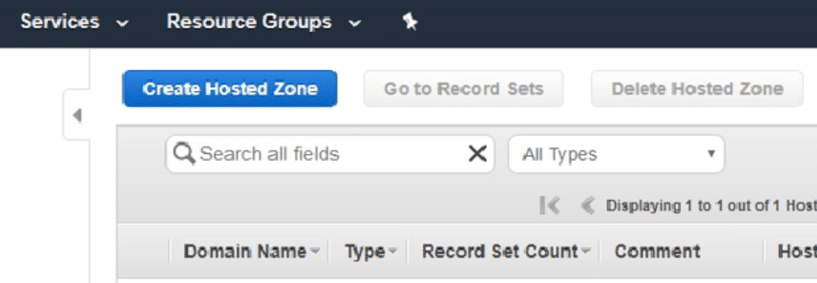
Step 4: Provide the domain you have created in the domain field and keep the website as a public hosted site
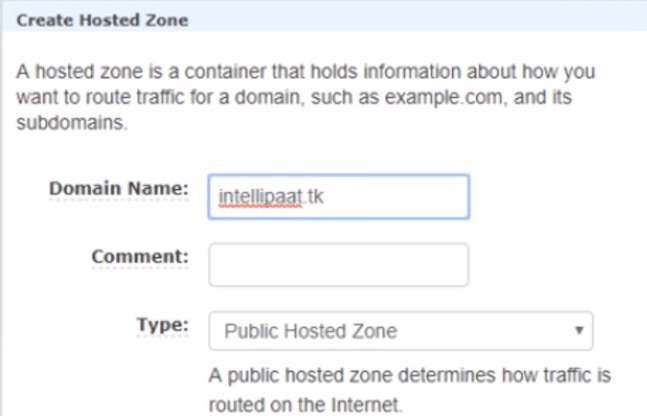
Step 5: Now, you will have a nameserver (NS) and Start of Authority (SOA) type recordsets. Copy the content of the nameserver value textbox and paste it in the Custom nameservers of your domain name
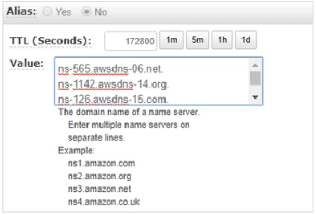
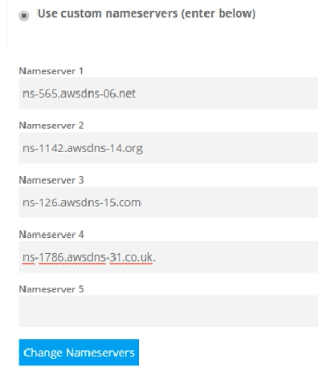
After pasting nameservers, click on Change Nameservers.Remove the dots at the end of your nameserver values in both places
Step 6: Create two recordsets with the type ‘A’ and leave one as the same. For the other, add ‘www’ so that both domain names redirect to the EC2 instance IP address you have provided. If you want to know how to create an EC2 instance, check out the AWS EC2 blog and do as per the hands-on steps mentioned there.
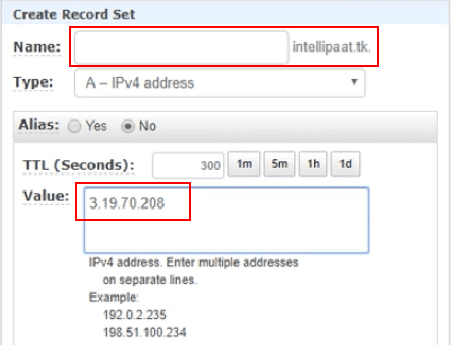
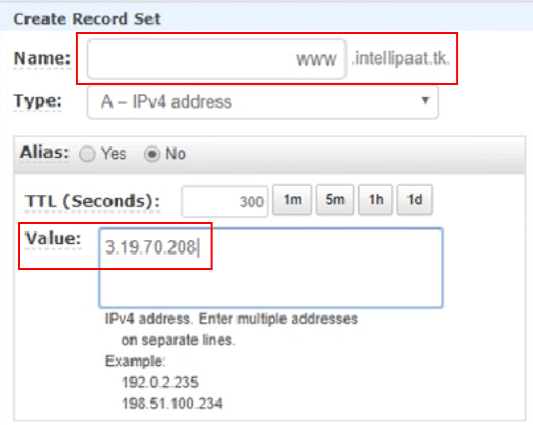
Step 7: After completing all these steps perfectly, type the domain name in your browser’s URL tab. As you can see, the website is now online and available publicly on the Internet

You have successfully hosted your first website!
In this what is amazon route 53 in AWS, we have discussed the concepts of Route 53, how it works, what are AWS route tables and the key features provided by Amazon Route 53. Keep visiting for more tutorials on Services offered by AWS.



